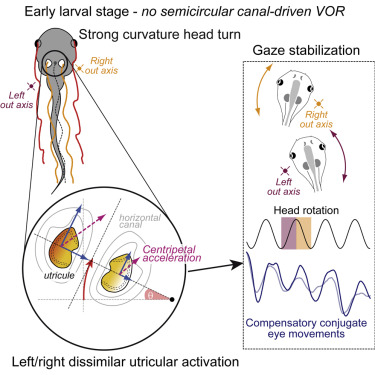当前位置:
X-MOL 学术
›
Curr. Biol.
›
论文详情
Our official English website, www.x-mol.net, welcomes your
feedback! (Note: you will need to create a separate account there.)
Stabilization of Gaze during Early Xenopus Development by Swimming-Related Utricular Signals.
Current Biology ( IF 8.1 ) Pub Date : 2020-01-10 , DOI: 10.1016/j.cub.2019.12.047 François M Lambert 1 , Julien Bacqué-Cazenave 1 , Anne Le Seach 2 , Jessica Arama 2 , Gilles Courtand 1 , Michele Tagliabue 2 , Selim Eskiizmirliler 2 , Hans Straka 3 , Mathieu Beraneck 2
Current Biology ( IF 8.1 ) Pub Date : 2020-01-10 , DOI: 10.1016/j.cub.2019.12.047 François M Lambert 1 , Julien Bacqué-Cazenave 1 , Anne Le Seach 2 , Jessica Arama 2 , Gilles Courtand 1 , Michele Tagliabue 2 , Selim Eskiizmirliler 2 , Hans Straka 3 , Mathieu Beraneck 2
Affiliation

|
Locomotor maturation requires concurrent gaze stabilization improvement for maintaining visual acuity [1, 2]. The capacity to stabilize gaze, in particular in small aquatic vertebrates where coordinated locomotor activity appears very early, is determined by assembly and functional maturation of inner ear structures and associated sensory-motor circuitries [3-7]. Whereas utriculo-ocular reflexes become functional immediately after hatching [8, 9], semicircular canal-dependent vestibulo-ocular reflexes (VORs) appear later [10]. Thus, small semicircular canals are unable to detect swimming-related head oscillations, despite the fact that corresponding acceleration components are well-suited to trigger an angular VOR [11]. This leaves the utricle as the sole vestibular origin for swimming-related compensatory eye movements [12, 13]. We report a remarkable ontogenetic plasticity of swimming-related head kinematics and vestibular end organ recruitment in Xenopus tadpoles with beneficial consequences for gaze-stabilization. Swimming of older larvae generates sinusoidal head undulations with small, similar curvature angles on the left and right side that optimally activate horizontal semicircular canals. Young larvae swimming causes left-right head undulations with narrow curvatures and strong, bilaterally dissimilar centripetal acceleration components well suited to activate utricular hair cells and to substitute the absent semicircular canal function at this stage. The capacity of utricular signals to supplant semicircular canal function was confirmed by recordings of eye movements and extraocular motoneurons during off-center rotations in control and semicircular canal-deficient tadpoles. Strong alternating curvature angles and thus linear acceleration profiles during swimming in young larvae therefore represents a technically elegant solution to compensate for the incapacity of small semicircular canals to detect angular acceleration components.
中文翻译:

在非洲爪蟾早期发育过程中,与游泳有关的脐静脉信号可稳定视线。
运动的成熟需要同时改善视线稳定性以保持视力[1、2]。稳定注视的能力,尤其是在协调运动能力很早出现的小型水生脊椎动物中,是由内耳结构和相关的感觉运动回路的组装和功能成熟所决定的[3-7]。孵化后眼球反射立即起作用[8,9],半规管依赖性前庭眼反射(VOR)随后出现[10]。因此,尽管相应的加速度分量非常适合触发角度VOR,但小的半圆形运河仍无法检测到与游泳有关的头部振动。这使the囊成为与游泳有关的代偿性眼球运动的唯一前庭起源[12,13]。我们报告了非洲爪蟾t中与游泳有关的头部运动学和前庭终末器官募集的显着的遗传可塑性,对凝视稳定具有有益的影响。游泳较大的幼虫会产生正弦形头部起伏,其左侧和右侧的曲率角较小,相似,可以最佳地激活水平半圆管。幼虫游泳会导致左右头部波动,曲率较窄,向心方向上的向心加速度分量很强,非常适合激活毛细胞并在此阶段替代缺乏的半规管功能。通过记录在对照和半规管缺损的s中偏心旋转过程中眼球运动和眼外运动神经元的记录,证实了膀胱信号替代半规管功能的能力。因此,在幼虫游泳过程中,强的交替曲率角以及由此产生的线性加速度曲线代表了一种技术上优雅的解决方案,可以弥补小半圆形运河无法检测角加速度分量的能力。
更新日期:2020-01-17
中文翻译:

在非洲爪蟾早期发育过程中,与游泳有关的脐静脉信号可稳定视线。
运动的成熟需要同时改善视线稳定性以保持视力[1、2]。稳定注视的能力,尤其是在协调运动能力很早出现的小型水生脊椎动物中,是由内耳结构和相关的感觉运动回路的组装和功能成熟所决定的[3-7]。孵化后眼球反射立即起作用[8,9],半规管依赖性前庭眼反射(VOR)随后出现[10]。因此,尽管相应的加速度分量非常适合触发角度VOR,但小的半圆形运河仍无法检测到与游泳有关的头部振动。这使the囊成为与游泳有关的代偿性眼球运动的唯一前庭起源[12,13]。我们报告了非洲爪蟾t中与游泳有关的头部运动学和前庭终末器官募集的显着的遗传可塑性,对凝视稳定具有有益的影响。游泳较大的幼虫会产生正弦形头部起伏,其左侧和右侧的曲率角较小,相似,可以最佳地激活水平半圆管。幼虫游泳会导致左右头部波动,曲率较窄,向心方向上的向心加速度分量很强,非常适合激活毛细胞并在此阶段替代缺乏的半规管功能。通过记录在对照和半规管缺损的s中偏心旋转过程中眼球运动和眼外运动神经元的记录,证实了膀胱信号替代半规管功能的能力。因此,在幼虫游泳过程中,强的交替曲率角以及由此产生的线性加速度曲线代表了一种技术上优雅的解决方案,可以弥补小半圆形运河无法检测角加速度分量的能力。











































 京公网安备 11010802027423号
京公网安备 11010802027423号